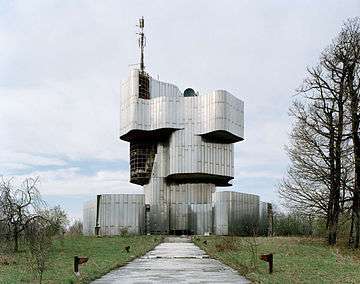Monument to the uprising of the people of Kordun and Banija
| Serbo-Croatian: Spomenik ustanku naroda Banije i Korduna | |
|
Monument at Petrova Gora in 2010. Today, it is in a much worse state, since a number of the stainless steel plates are stolen. | |
| Artist | Vojin Bakić |
|---|---|
| Year | 1981 |
| Location | Petrovac, Petrova Gora, Croatia |
| 45°18′58.9″N 15°48′17.6″E / 45.316361°N 15.804889°ECoordinates: 45°18′58.9″N 15°48′17.6″E / 45.316361°N 15.804889°E | |
Monument to the uprising of the people of Kordun and Banija (simply known as Petrova Gora Monument) is a World War II monument built on Petrovac, the highest peak of Petrova Gora (English: Peter's Mountain), a mountain range in central Croatia. It was the site of one of the tragic World War II episodes, when about 300 desperate Serb peasants armed only with pitchforks, died attacking members of the Ustaše militia at the top of the mountain, during breakthrough of the enemy ring in 1942. The monument is a symbol of suffering and heroic struggle foremost of the Serbian population in this region, who, starting in the spring of 1941, had been the subject of Ustaše crimes and persecution. After the founding of the first partisan units in Kordun and Banija Croats and Serbs fought together against fascism and occupation. This region was also a founding site of the Main headquarters of the PLA of Croatia, Partisan Hospital was active during the whole war and in 1944 the 3rd session of ZAVNOH was held in Topusko.[1]
Author of the monument is Vojin Bakić. The construction of the monument was completed in 1981.
Work on the monument
After finishing the Monument to the victory of the people of Slavonia, Bakić won the first prize for another major project in 1970, in the second round of competition. In the first competition, first prize has been won by Igor Toš, but his project was canceled after conflicts around the concept of building the monument.[1] chairman of the board for the construction of the monument was Vladimir Bakarić. Monument construction lasted for a decade, until it was finally completed in 1981 and officially opened on 4 July 1982.
Monument description

Monument is mostly architectural work, made of reinforced concrete and covered with slabs of stainless steel.[2] The interior of the monument was laid museum contained a permanent display related to People's liberation struggle in the region, while around the monument was complex for recreation. By placing the museum, the monument actually received educational exhibition function. At the top of the monument is a point from which is a view towards Slovenia, Bosnia and Zagreb.[3]
Scholar Tonko Maroević notes that Bakić drew its inspiration from its sculpture sliced segments, by which he actually meant that it was Bakić's "step backwards", since the sculpture was his work from the mid-1970s. Already in the early 1980s Bakić felt fatigue in his work, so this is one of the reasons for seeing models in the earlier sculpture, Maroević concluded.[4]
Devastation after 1991
After 1991, monuments and memorial complexes were neglected, and the museum was devastated after 1995, and continues to be damaged. Local people steal stainless steel from the monument and the Local and state governments do not implement any sanctions against the perpetrators despite protests of the Antifascist organizations.[5] In addition, "Transmitters and Communications Ltd." a transmitter is set at the top of the monument, which further undermines its appearance.[6]
An Important role in the revitalization and care for the monument is the curatorial collective WHW since 2004. WHW organized two exhibitions in 2007 and 2008 (in Graz and Zagreb) which emphasized the importance of Bakić's legacy. They also initiated the action "Petrova Gora: yesterday, tomorrow, how to think Petrova Gora" in 2013.[1]
In popular culture
The monument appeared as the artwork of American and New Zealand rock band Unknown Mortal Orchestra's debut self-titled album.
See also
- Petrova Gora Memorial Park
- List of Yugoslav World War II monuments and memorials in Croatia
References
- 1 2 3 Spomenik Vojina Bakića na Petrovoj gori oronuli kostur pred raspadom (12-29-2013), Retrieved 7 November 2014
- ↑ Dušan Matić. Vojin Bakić, moj prijatelj. "Euroknjiga", Zagreb 2007, p. 59 and 115
- ↑ Pionirov glasnik: ovde je metak ludovao, Retrieved 7 November 2014
- ↑ Tonko Maroević. Vojin Bakić. "Globus", Zagreb 1998, p. 40
- ↑ Anali Galerije Antuna Augustinčića. "Antun Augustinčić" Klanjec 2006, p. 418-419
- ↑ Boris Čučković, "Tradicija zaborava", in: Chronicles of SKD Prosveta, 2010, p. 242
External links
| Wikimedia Commons has media related to Petrova Gora Monument. |
- Spomenik Vojina Bakića na Petrovoj gori oronuli kostur pred raspadom (29 December 2013), Retrieved 7 November 2014.
